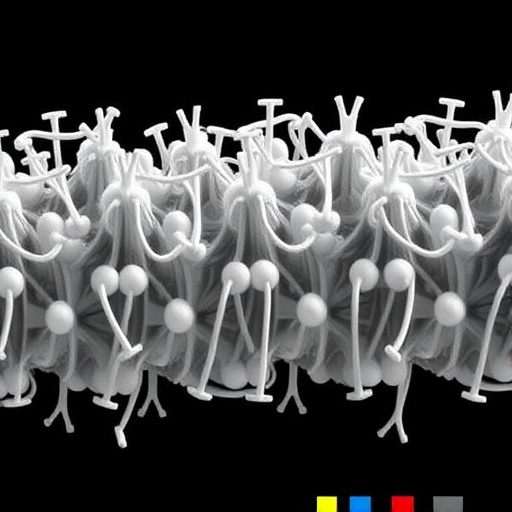In a groundbreaking study soon to be published in International Microbiology, researchers have unveiled new insights into the structural and functional dynamics of surfactin, particularly focusing on the molecular variant surfactin-C15. This innovative research has been conducted on a novel strain of Bacillus subtilis, designated as B-11, and aims to elucidate the mechanisms underlying phospholipid membrane permeabilization and cellular content leakage. As antibiotic resistance continues to pose a significant threat to public health, understanding surfactin’s bioactive properties could provide a pivotal avenue for future therapeutic interventions.
The research team, led by A. Sani alongside collaborators JY. Li and C.H. Ali, has utilized a combination of computational modeling and empirical experimental methodologies to explore the interactions of surfactin-C15 with lipid bilayers. This dual approach enabled a more profound understanding of how surfactin operates at a molecular level to disrupt membrane integrity. By focusing on this specific variant of surfactin, the study highlights not only the structural components of the peptide but also its potential applications in antimicrobial treatments.
.adsslot_E2WyhYL1FI{ width:728px !important; height:90px !important; }
@media (max-width:1199px) { .adsslot_E2WyhYL1FI{ width:468px !important; height:60px !important; } }
@media (max-width:767px) { .adsslot_E2WyhYL1FI{ width:320px !important; height:50px !important; } }
ADVERTISEMENT
Utilizing molecular dynamics simulations, the researchers modeled the interactions between surfactin-C15 and lipid bilayers, providing a visual and quantitative framework for understanding these processes. These simulations not only depict the physical changes undergone by the membrane during surfactin interaction but also illuminate the specific sequences through which membrane disruption occurs. The simulations were complemented by experimental validation, ensuring that the computational predictions align with observable phenomena in lab settings.
Notably, the study delves into the implications of phospholipid bilayer destabilization by surfactin-C15. The leakage of intracellular constituents is a critical outcome when cells are exposed to surfactin, which can lead to loss of functional integrity and ultimately cell death. The researchers conducted assays measuring leakage of nucleic acids and other cytoplasmic contents to assess the extent of membrane damage caused by surfactin treatment. These findings emphasize the potential for surfactin-C15 to act as a biocide, targeting not only bacterial membranes but perhaps offering insights into broader antimicrobial strategies.
Moreover, the study discusses the structure-activity relationship of surfactin-C15 as a crucial factor in determining its efficacy. By characterizing the molecular configuration and functional groups present on the lipopeptide, researchers were able to correlate certain structural features with observed biological activities. This knowledge could accelerate the design of new surfactin derivatives aimed at enhancing antimicrobial properties against a wider spectrum of pathogens.
The implications of this research extend beyond simple antimicrobial activity; they raise pertinent questions about the potential for surfactin-C15 in agricultural applications and food safety. Its ability to disrupt bacterial membranes could make it an essential tool not only for controlling plant pathogens but also for disinfection purposes in food processing environments. Furthermore, understanding surfactin’s mechanism of action opens new avenues for developing alternative strategies to combat antibiotic-resistant bacteria, a pressing global health concern.
As bioactive compounds continue to be an area of intense research focus, surfactin and its analogs stand out for their multifunctional capabilities. Beyond their direct antimicrobial effects, they could facilitate the development of novel delivery systems for drugs, particularly in overcoming the challenges posed by biofilm-associated infections. Research into the utilization of surfactins in pharmaceutical formulations as carriers for hard-to-deliver drugs is a promising area for future exploration.
Overall, the study led by Sani and colleagues signifies a major advancement in understanding the functional dynamics of surfactin-C15. By bridging computational insights and experimental data, the research not only solidifies surfactin’s role in cellular interactions but also sets the stage for future innovations in microbial control and therapeutics. The implications of this research are extensive, hinting at the capacity for surfactin derivatives to revolutionize how we approach both microbial infections and biocontrol methodologies.
As this research paves the way for further investigations, one can anticipate a surge of interest surrounding surfactin’s potential applications. The scientific community will be eager to explore whether surfactin-C15 can be synthesized in larger quantities efficiently and what modifications can enhance its efficacy. With sustained research efforts, surfactin-C15 may soon become a formidable ally in the quest to combat microbial threats in various fields ranging from healthcare to agriculture.
The concerted efforts of the research team and their pioneering findings present a hopeful outlook for the application of surfactin derivatives in various domains. This opens up discussions regarding the sustainable and therapeutic potential of natural compounds, reinforcing nature’s role as a source of innovation in scientific advancements. As we look ahead, the enthusiasm surrounding the versatility of surfactin will undoubtedly foster a deeper investigation into its capabilities and a broader understanding of its place within the realm of microbiology.
In conclusion, the multi-faceted properties of surfactin-C15 extend its relevance across various scientific fields, spotlighting its significance in addressing critical challenges in microbial resistance. With more research on the contributions of surfactin and its derivatives, we might soon witness transformative changes in how we approach infections and maintain health across ecosystems.
Subject of Research:
Phospholipid membrane permeabilization and leakage of cell content by surfactin-C15 derived from B. subtilis B-11 strain.
Article Title:
Phospholipid membrane permeabilization and leakage of cell content by surfactin-C15 from novel B. subtilis B-11 strain: a computational and experimental analysis.
Article References:
Sani, A., Li, JY., Ali, C.H. et al. Phospholipid membrane permeabilization and leakage of cell content by surfactin-C15 from novel B. subtilis B-11 strain: a computational and experimental analysis. Int Microbiol (2025). https://doi.org/10.1007/s10123-025-00683-2
Image Credits:
AI Generated
DOI:
https://doi.org/10.1007/s10123-025-00683-2
Keywords:
Surfactin, Bacillus subtilis, membrane permeabilization, antimicrobial properties, phospholipid bilayers, computational modeling, microbial resistance, biocontrol, biochemistry.
Tags: antibiotic resistance solutionsantimicrobial treatmentsBacillus subtilis B-11bioactive surfactin applicationscellular content leakagecomputational modeling in microbiologycyclic lipopeptide propertiesempirical methodologies in biochemistrymembrane integrity disruptionmolecular dynamics of surfactinphospholipid membrane permeabilizationsurfactin-C15





